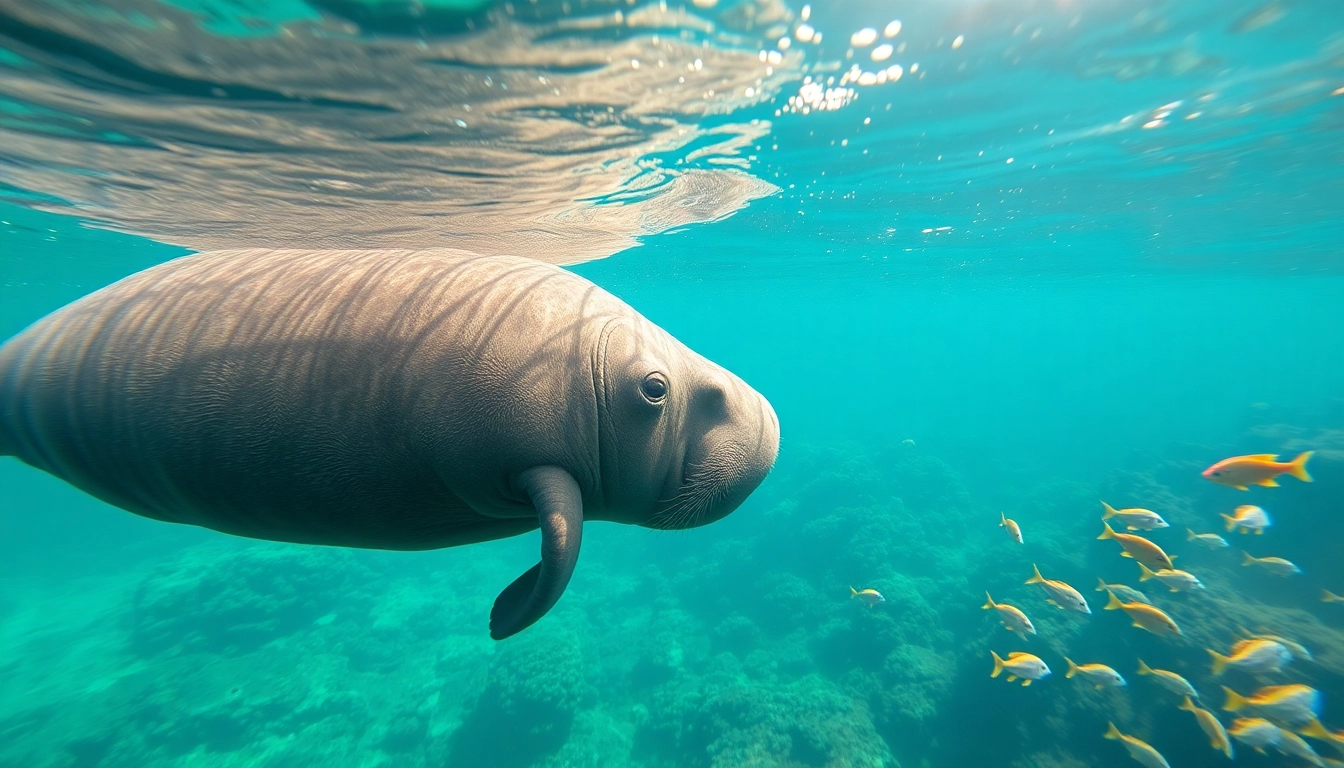Introduction to Manatees Puerto Rico
Manatees, often referred to as sea cows, are gentle giants that roam the warm coastal waters and rivers of Puerto Rico. These marine mammals are a vital part of the island’s ecosystem, playing a crucial role in maintaining the health of seagrass beds and contributing to the biodiversity of coastal habitats. For those interested in witnessing these magnificent creatures, understanding their biological characteristics and the ecological context is essential. This guide will delve into manatees puerto rico, their conservation status, and how to ethically observe them in their natural environment.
Understanding the Species
Belonging to the family Trichechidae, the Caribbean manatee (Trichechus manatus) is distinguished by its large, rounded body and paddle-shaped flippers. This species is typically a grayish color, with occasional brownish shades or patterns, which help them blend into their natural habitat. A typical adult can weigh between 800 to 1,200 pounds and measure around 10 to 13 feet in length. One of their most adorable traits is their whiskered snout, designed for grazing on aquatic vegetation.
Importance of Manatees in Marine Ecosystems
Manatees play a pivotal role in shaping their environment. As herbivores, they primarily feed on seagrass, which they consume in large quantities. This feeding behavior not only helps control seagrass growth but also promotes the health of underwater ecosystems. By grazing on seagrass, manatees stimulate root growth, which ultimately aids in creating a stable substrate for other marine life. Additionally, the movements of manatees through seagrass beds help distribute nutrients, fostering a diverse habitat for various fish species and other marine organisms.
Current Conservation Status
The Caribbean manatee is classified as a vulnerable species by the International Union for Conservation of Nature (IUCN). Historically, their populations have been threatened by habitat loss, collisions with boat traffic, and illegal hunting. Conservation efforts in Puerto Rico include establishing marine protected areas and rehabilitation centers where injured or orphaned manatees can be cared for. Local initiatives aim to raise awareness about the importance of manatees and their habitats, promoting responsible tourism practices to mitigate human impact.
Best Locations to Observe Manatees Puerto Rico
For enthusiasts looking to catch a glimpse of these gentle creatures, Puerto Rico offers several prime locations for manatee sightings. Each spot provides a unique setting and different opportunities for interaction with the local marine environment.
Top Spots for Manatee Viewing
- Condado Lagoon: Located in San Juan, this urban lagoon is a surprising hotspot for manatee sightings. The sheltered waters provide an ideal habitat, and visitors often report seeing manatees swimming close to the surface.
- La Parguera: This coastal village is renowned for its bioluminescent bay and adjacent seagrass flats, making it another excellent location for manatee sightings. Kayaking through the clear waters allows for an up-close view of these tranquil grazers.
- Jobos Bay National Estuarine Research Reserve: With its diverse ecosystems, Jobos Bay serves as a feeding ground and nursery for various marine species, including manatees. The reserve offers guided tours that educate visitors on local wildlife.
- Humacao Nature Reserve: This area features lagoons and mangroves where manatees can often be seen. The combination of habitats supports an array of wildlife, and boat tours often include manatee observation opportunities.
Seasonal Considerations for Sightings
While manatees can be present year-round, certain times may offer enhanced chances for sightings. Typically, manatees are more visible during the warmer months, from late spring through early fall, when they venture into shallower waters to feed on seagrass beds. Observers often have the best luck during early mornings or late afternoons when manatees come to the surface for air.
Local Regulations to Protect Manatees
Puerto Rico has implemented several regulations to safeguard its manatee populations. These include speed limits for boats in designated manatee protection areas, no-wake zones, and guidelines for wildlife viewing. It is essential for visitors to adhere to these regulations not only to protect manatees but also to ensure a sustainable tourism experience. Responsible viewing practices include maintaining a safe distance and refraining from touching or feeding the animals.
Activities Involving Manatees Puerto Rico
Engaging with manatees in a mindful way can enhance the experience for both visitors and the animals. Puerto Rico offers various activities centered around these aquatic mammals, providing educational experiences that promote conservation.
Guided Tours and Experiences
Several local companies offer guided tours that focus on manatee observation. These tours often combine kayaking or boating experiences with educational components, allowing participants to learn about manatees, their habitats, and conservation efforts in the region. Many tours are led by knowledgeable guides who provide insights into the ecological significance of manatees and the challenges they face.
Educational Programs and Workshops
Organizations involved in wildlife conservation frequently host workshops and educational programs to engage the community and promote awareness about manatees. These programs may include lectures, hands-on experiences, and field trips aimed at schools and families. Through education, participants gain a deeper understanding of the challenges faced by manatees and the importance of preserving their habitats.
Responsible Tourism Practices
Tourism can pose risks to wildlife; therefore, adopting responsible practices is crucial. Visitors are encouraged to participate in eco-friendly activities, such as using non-motorized boats and avoiding disturbing wildlife. Additionally, travelers can opt for tours that prioritize conservation efforts and follow local regulations to minimize human impact on manatee populations.
Challenges Facing Manatees Puerto Rico
Despite conservation efforts, manatees in Puerto Rico face numerous challenges that threaten their survival. Understanding these challenges is essential for implementing effective solutions.
Environmental Threats and Vulnerabilities
Manatees are particularly vulnerable to environmental changes, such as habitat loss due to coastal development, pollution, and climate change. Seagrass beds, their primary food source, can be adversely affected by nutrient runoff and reduced water quality. Additionally, the warming of ocean temperatures poses risks, as manatees typically thrive in warmer waters. Increased temperatures and changing ocean conditions can lead to shifts in their habitat range, thereby complicating conservation efforts.
Human Impact on Habitats
Human activity is a significant contributor to the challenges faced by manatees. Boat strikes remain a leading cause of injury and mortality among manatees in Puerto Rico. As coastal areas develop, manatees may find their natural habitats fragmented or diminished, diminishing their foraging and breeding opportunities. Increased tourism and commercial activities can also result in pollution and habitat degradation, further stressing local manatee populations.
Efforts to Mitigate Risks
Conservation organizations and governmental agencies collaborate on various initiatives aimed at addressing the threats to manatees. These efforts include habitat restoration, public education campaigns, research on manatee behavior and populations, and stricter regulations on boating activities in protected areas. Engaging local communities and promoting awareness of the importance of manatees is key to fostering a culture of conservation.
Getting Involved with Manatee Conservation
Everyone can contribute to the conservation of manatees in Puerto Rico, whether through volunteering, supporting local organizations, or increasing awareness.
Volunteer Opportunities and Programs
Many conservation organizations actively seek volunteers to assist with various initiatives, such as beach cleanups, research surveys, and educational outreach programs. Volunteering not only aids in the conservation of manatees but also allows individuals to gain firsthand knowledge about marine ecosystems and the importance of protecting them.
Supporting Local Conservation Organizations
One of the most effective ways to help manatees is by supporting local conservation organizations focused on marine life and habitat protection. Donations, whether financial or in-kind, can significantly impact ongoing efforts to rescue and rehabilitate injured manatees and restore their natural habitats.
How to Spread Awareness and Educate Others
Educating others about manatees and their ecological significance can lead to more informed perspectives on conservation. Sharing information via social media, hosting local events or talks, and encouraging responsible tourism practices within personal networks contributes to a broad awareness of the issues facing manatees in Puerto Rico. By fostering a passion for marine wildlife, individuals can influence cultural attitudes toward conservation and sustainability.



